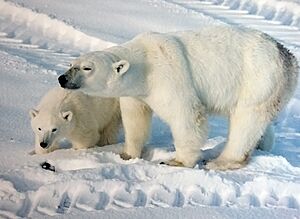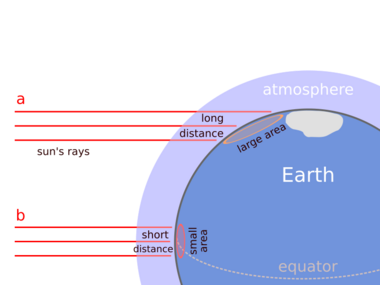Polar climate facts for kids
The polar climate is a type of weather found in very cold places. These areas never have warm summers. In fact, every month of the year has an average temperature below 10 °C (50 °F).
Polar climates cover more than 20% of Earth's surface. Most of these places are far from the equator and close to the North and South Poles. Here, winter days are very short, and summer days are very long. Sometimes, the sun stays up for the whole season!
These climates have cool summers and very cold winters. In some places, like ice caps, there's no real summer at all. This leads to lands with no trees, just tundra plants, glaciers, or thick layers of ice. Scientists use the letter E to show polar climates in the Köppen climate classification system.
Contents
Types of Polar Climate
There are two main types of polar climate:
- ET (Tundra climate)
- EF (Ice Cap climate)
Tundra Climate
A tundra climate has at least one month where the average temperature is above 0 °C (32 °F). Even though it gets above freezing, it's still too cold for most trees, like pine or fir trees, to grow. However, special plants like the arctic poppy can survive here.
Ice Cap Climate
An ice cap climate is even colder. No month has an average temperature above 0 °C (32 °F). This means no plants can grow at all. Instead, ice builds up over time, forming huge sheets that can flow or slide.
Many high mountains also have very cold climates. But because this cold is due to how high up they are, it's called an Alpine climate. Alpine climates can be like either tundra or ice cap climates.
Where Are Polar Climates Found?

The continent of Antarctica is almost entirely covered by the ice cap polar climate. Most of Greenland also has this icy climate, except for a few coastal areas. The tops of many tall mountains around the world also have ice cap climates because they are so high up.
Coastal parts of Greenland that don't have permanent ice sheets have the slightly warmer tundra climate. Large areas of northern Siberia and northern Iceland also have tundra climates. You can find tundra in northern Canada and northern Alaska, too. The very northernmost parts of Canada even have ice cap climates.
In the Southern Hemisphere, some parts of southern Argentina (like Tierra del Fuego) and islands such as the South Shetland Islands and Falkland Islands have tundra climates. These places are closer to the equator than the Arctic tundras, but they are still very cold.
The Arctic
Some parts of the Arctic are covered in ice or snow all year, especially near the North Pole. Almost all of the Arctic has ice or snow on its surface for long periods.
In January, average temperatures range from about −40 to 0 °C (−40 to 32 °F). Winter temperatures can drop below −50 °C (−58 °F) in many areas. In July, average temperatures are usually between −10 to 10 °C (14 to 50 °F). Some land areas might even get above 30 °C (86 °F) in summer, but this is rare.
The Arctic is mostly an ocean surrounded by land, like Russia and Canada. The ocean water helps to keep the climate from getting too extreme. Water never gets colder than about −2 °C (28 °F). Even when covered by ice, this relatively warm water stops the North Pole from being the coldest place in the Northern Hemisphere. This is also why Antarctica is much colder than the Arctic. In summer, the ocean keeps coastal areas from getting too hot, just like it does in places with maritime climates.
Antarctica
The climate of Antarctica is the coldest on Earth. The lowest natural temperature ever recorded was in Antarctica: −89.2 °C (−128.6 °F) at Vostok Station in 1983.
Antarctica is also very dry. It's technically a desert, sometimes called a polar desert. It only gets about 166 millimetres (6.5 in) of precipitation each year. This is because weather systems rarely move far into the continent.
Mountains with Polar Climates
The tops of most mountains have polar climates, even if they are closer to the equator. This is because temperatures drop as you go higher up.
- Mountains in the Rocky Mountains, Alps, and Caucasus ranges have tundra climates.
- Some mountains in the Andes, Saint Elias Mountains, and most mountains in the Himalayas, Karakoram, Hindu Kush Range, Pamir Mountains, Tian Shan Mountains, and Alaska Range have ice cap climates at very high elevations. They also have tundra climates at slightly lower elevations.
- Only the very top of Mount Rainier in the Cascade Range has an ice cap climate.
How We Measure Polar Climates
Scientists have tried to define exactly what makes a climate "polar."
Wladimir Köppen, a climatologist, noticed something interesting. He saw that the line where trees stop growing in the Arctic and Antarctic matched up with places where the average temperature in the warmest month of the year was below 10 °C (50 °F). This means if the warmest month is colder than 10 °C (50 °F), forests cannot grow there. You can learn more about this in the Köppen climate classification.
See also
 In Spanish: Clima polar para niños
In Spanish: Clima polar para niños
- Tundra climate
- Ice cap climate
- Köppen climate classification
- Arctic oscillation
- Climate change in the Arctic
- Global warming in Antarctica




